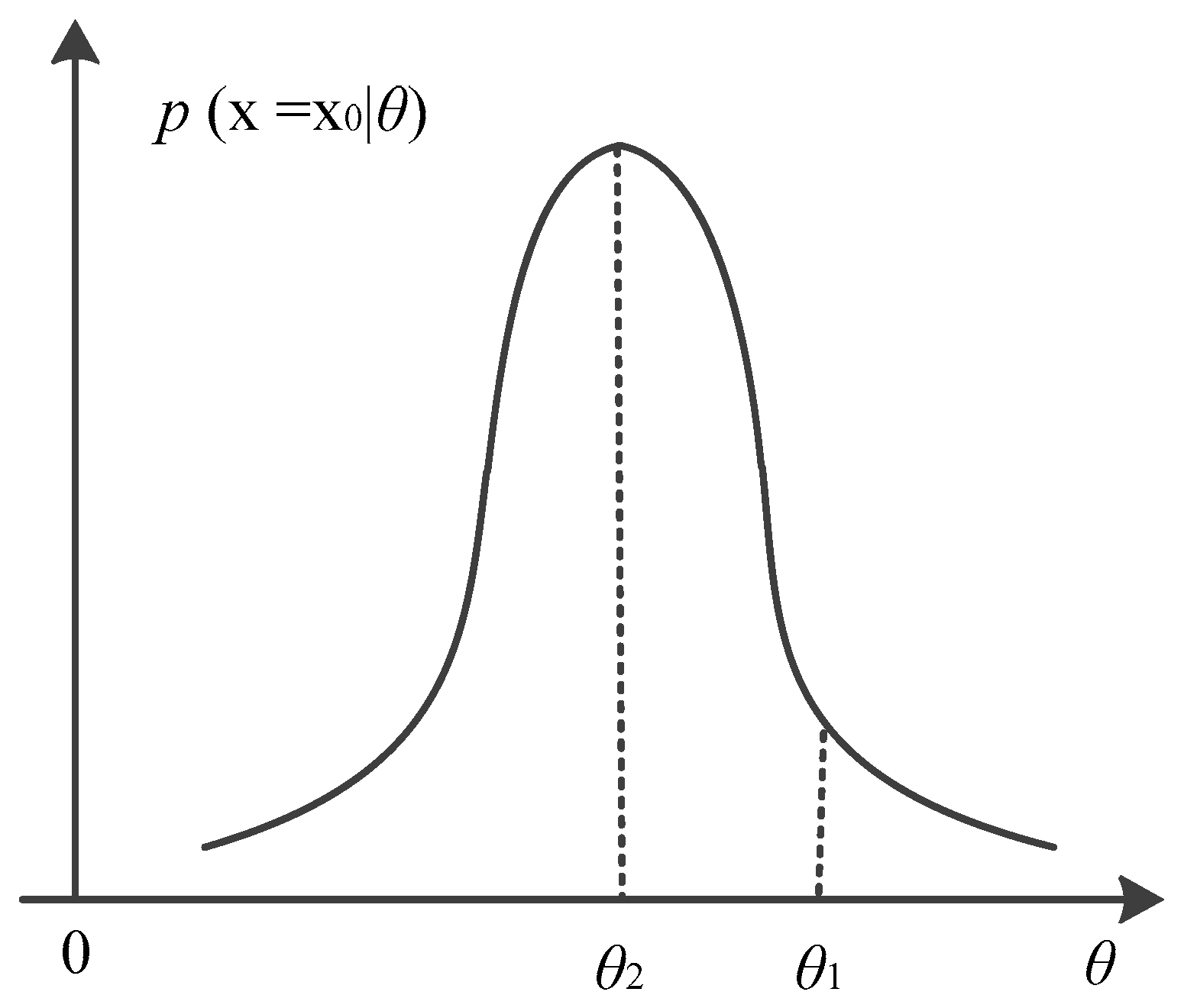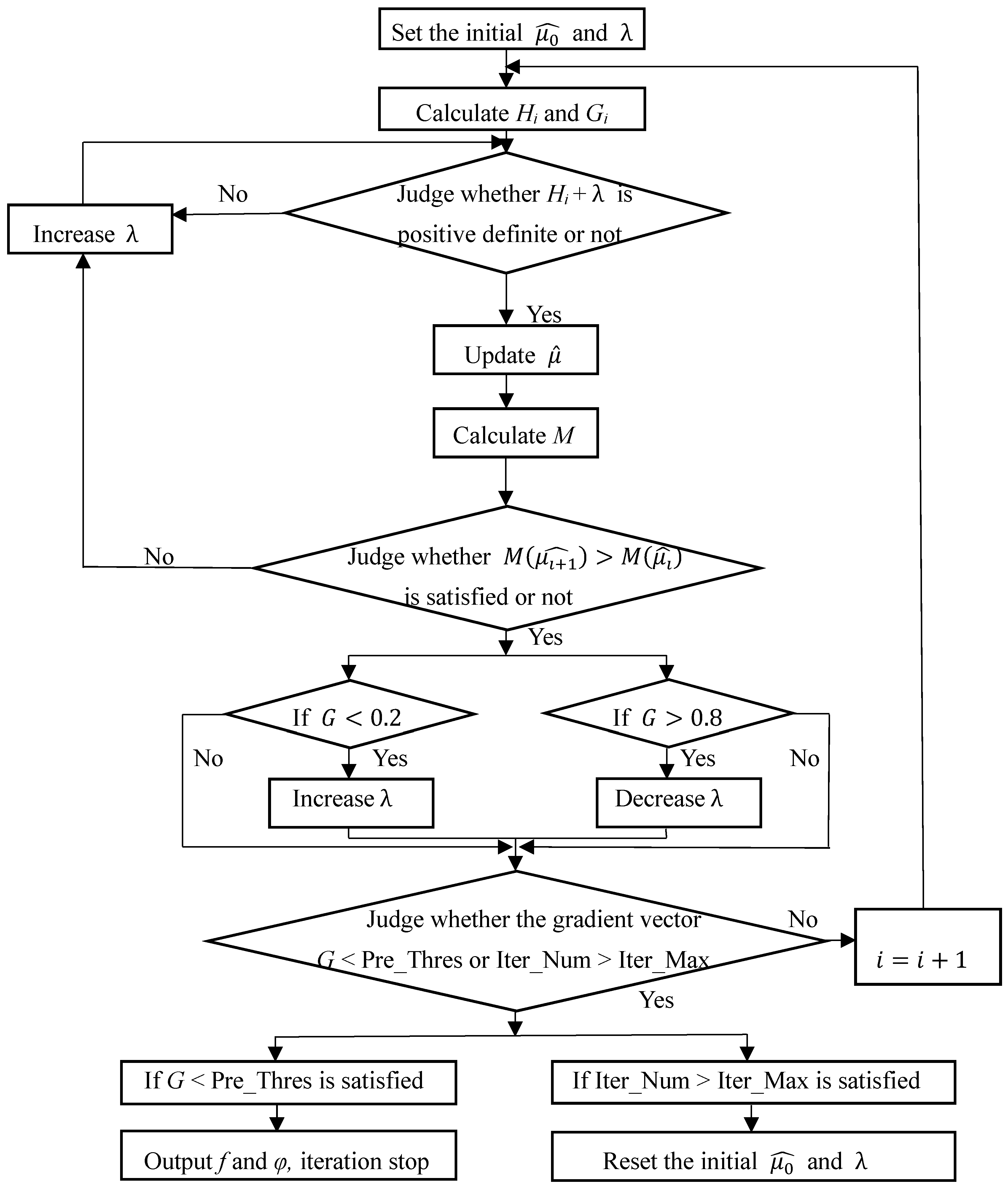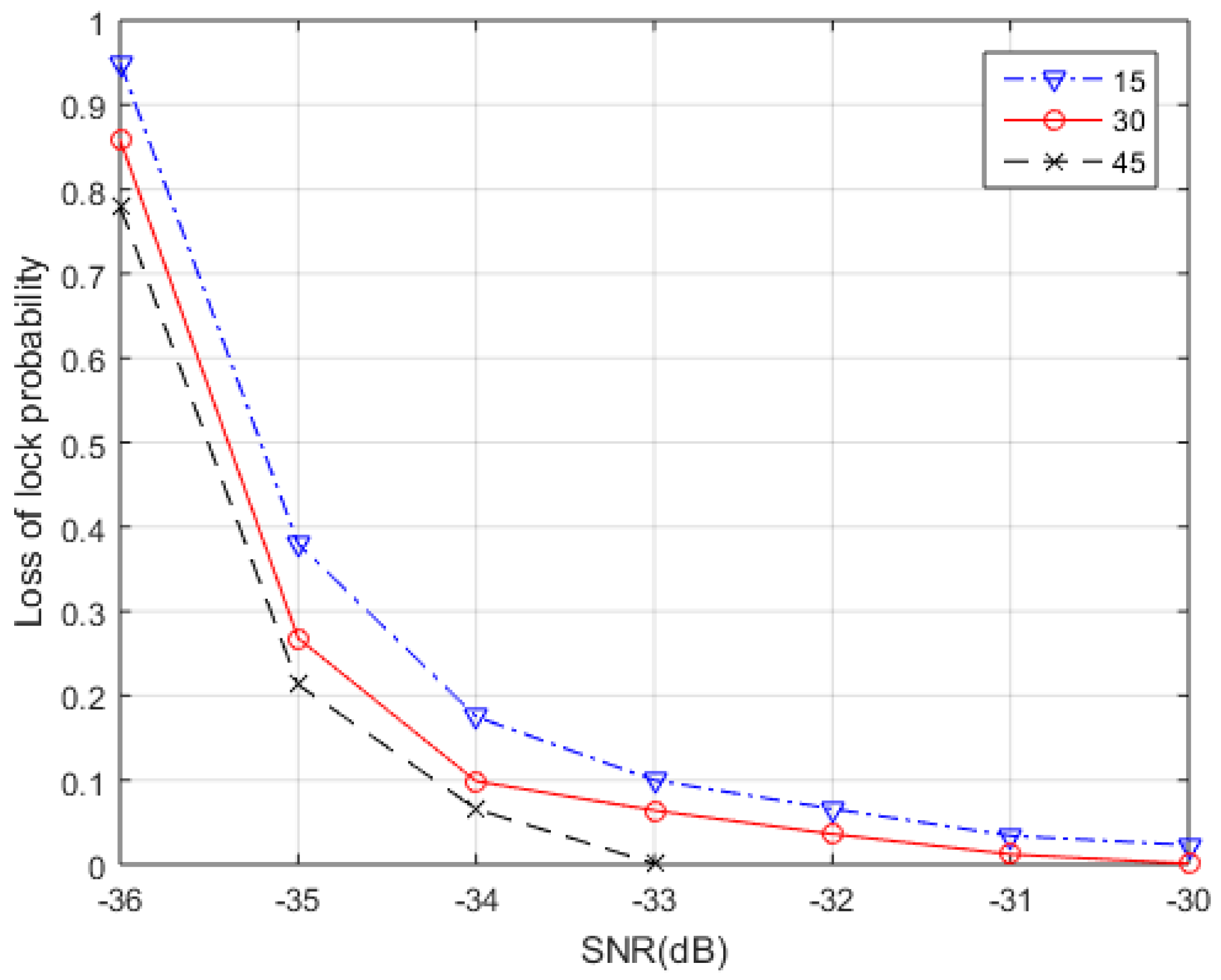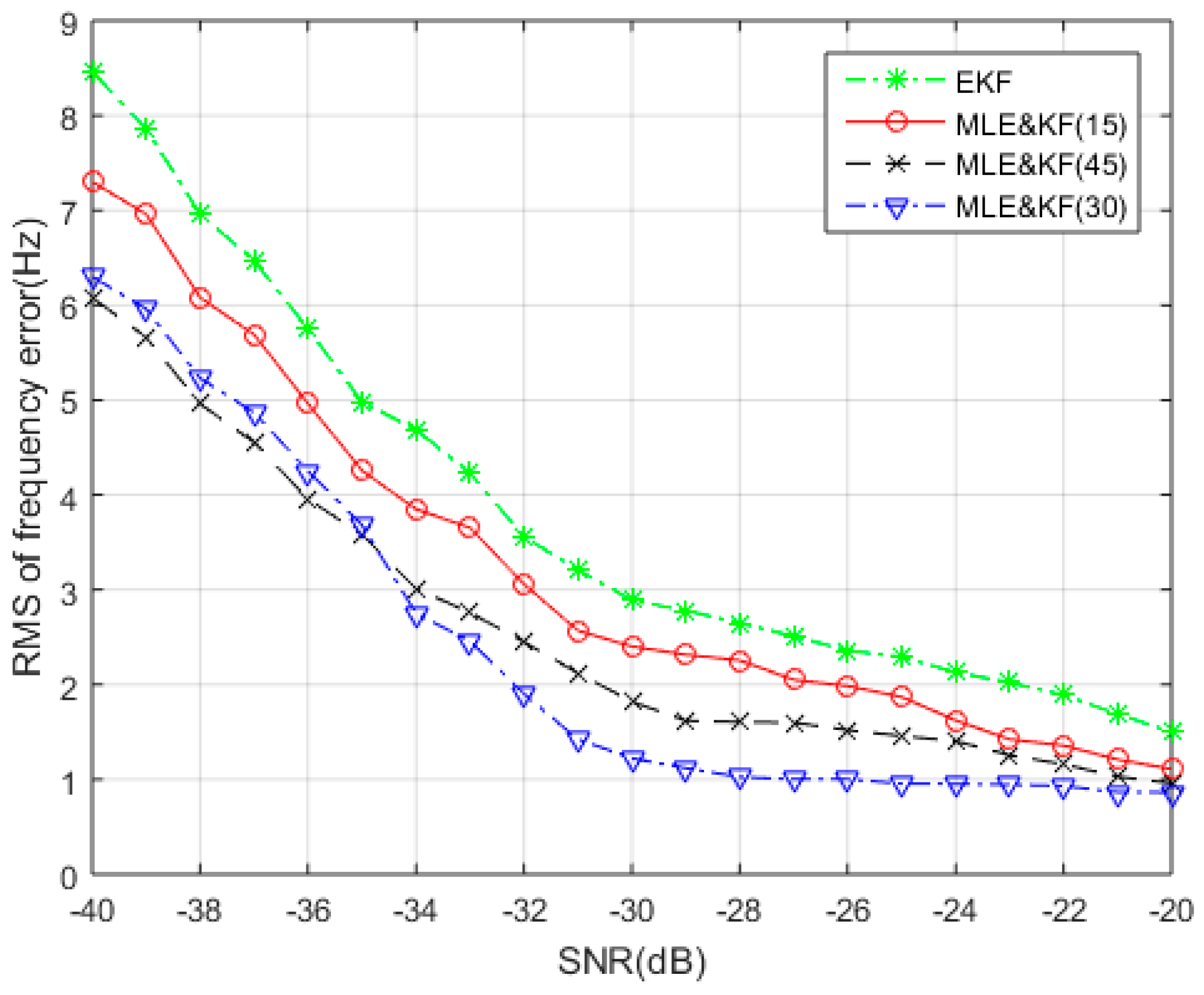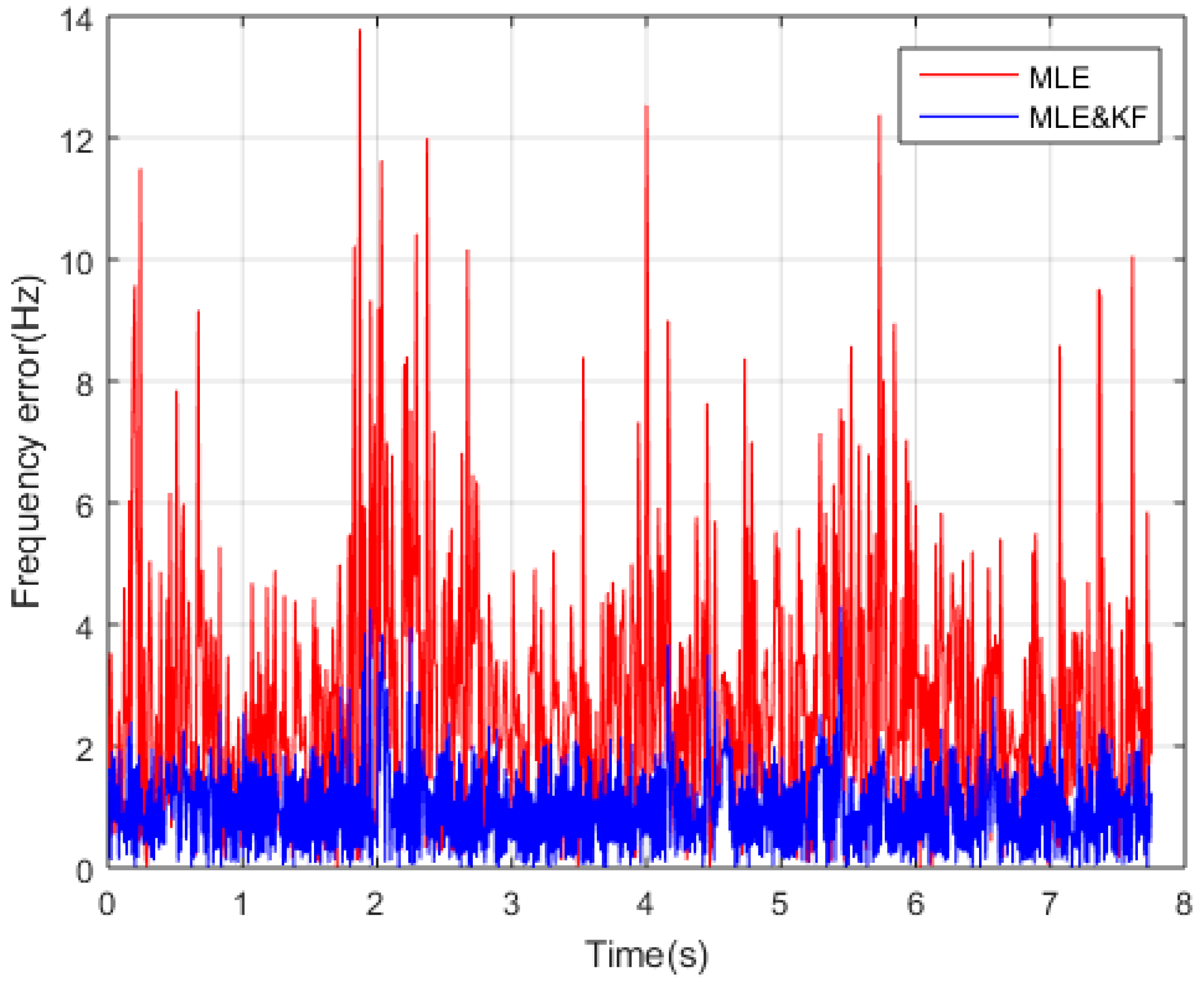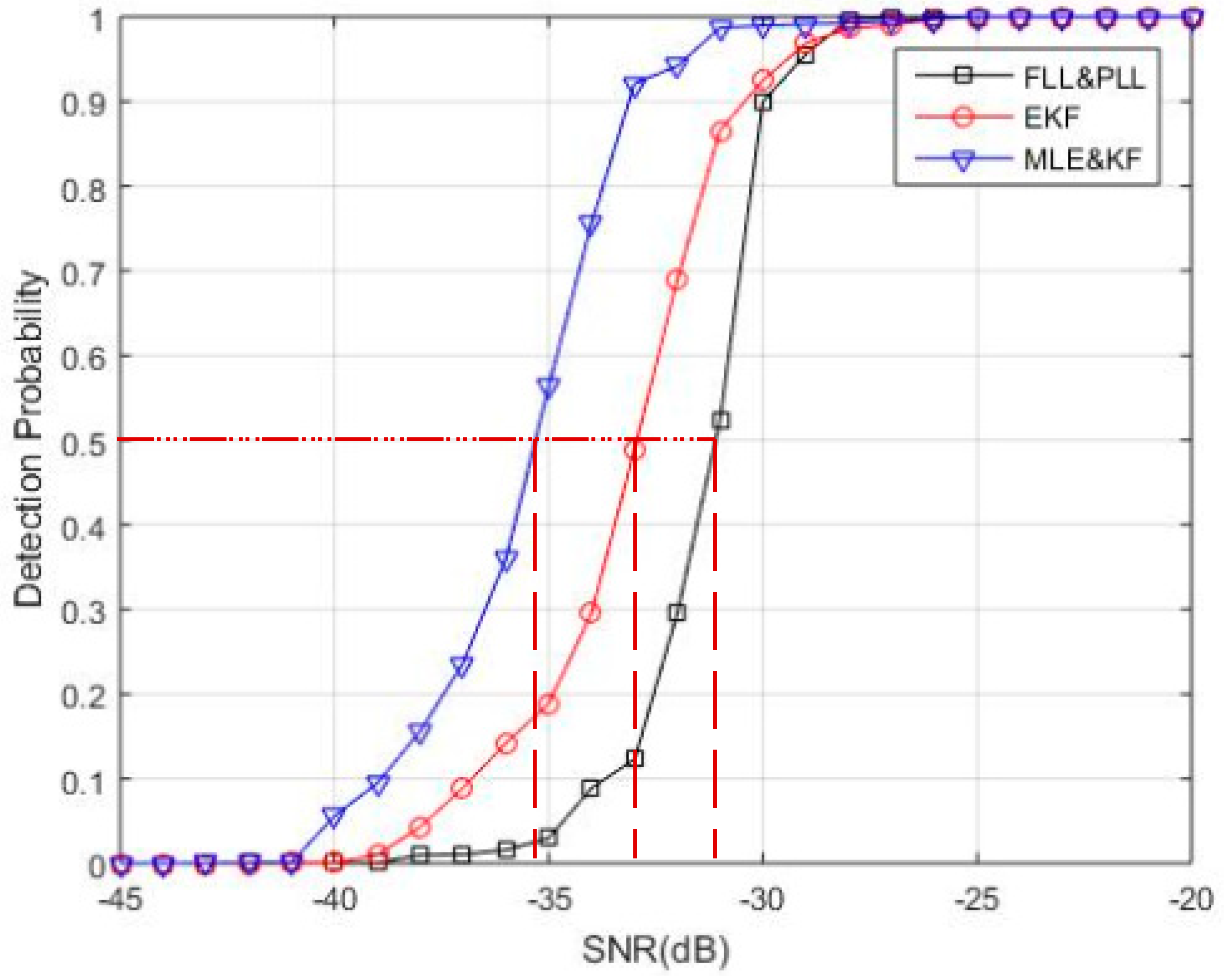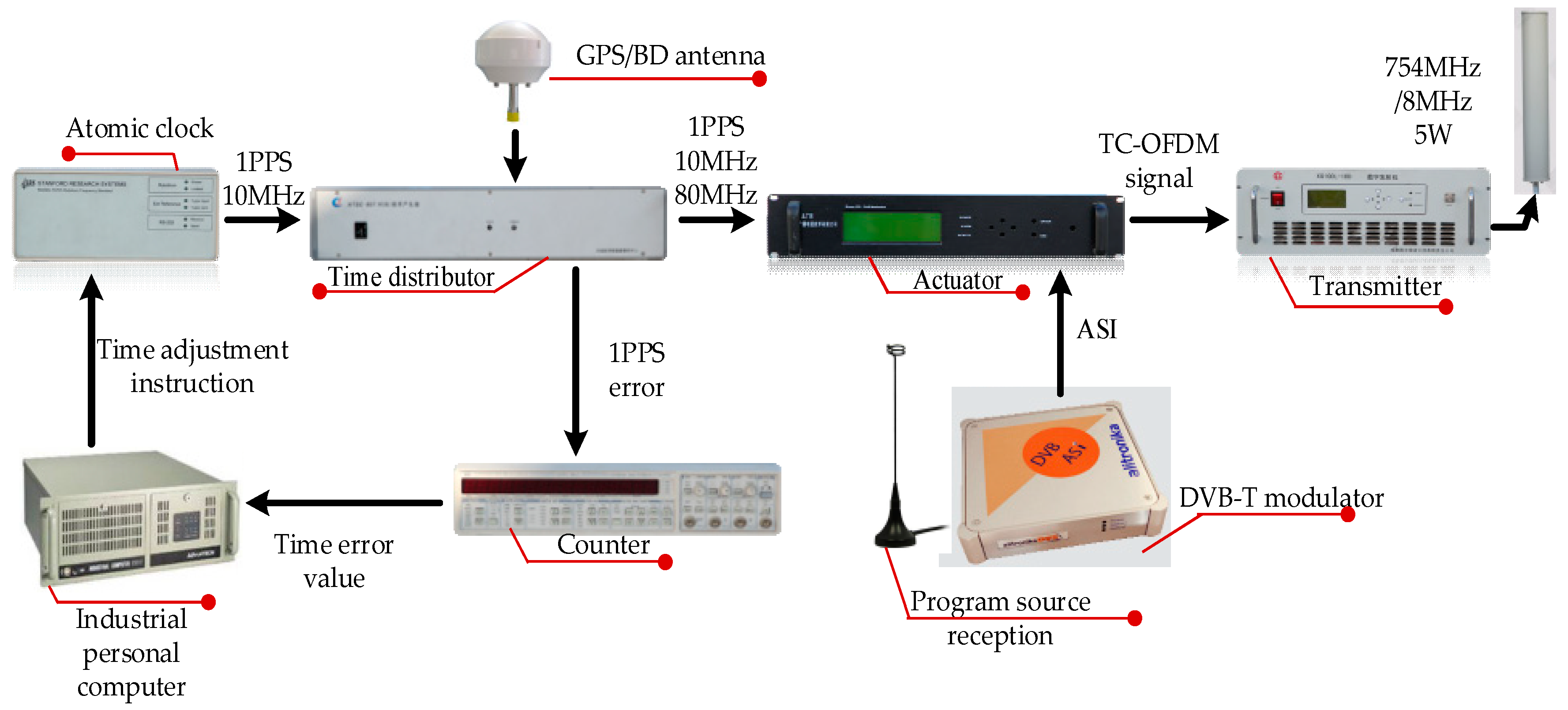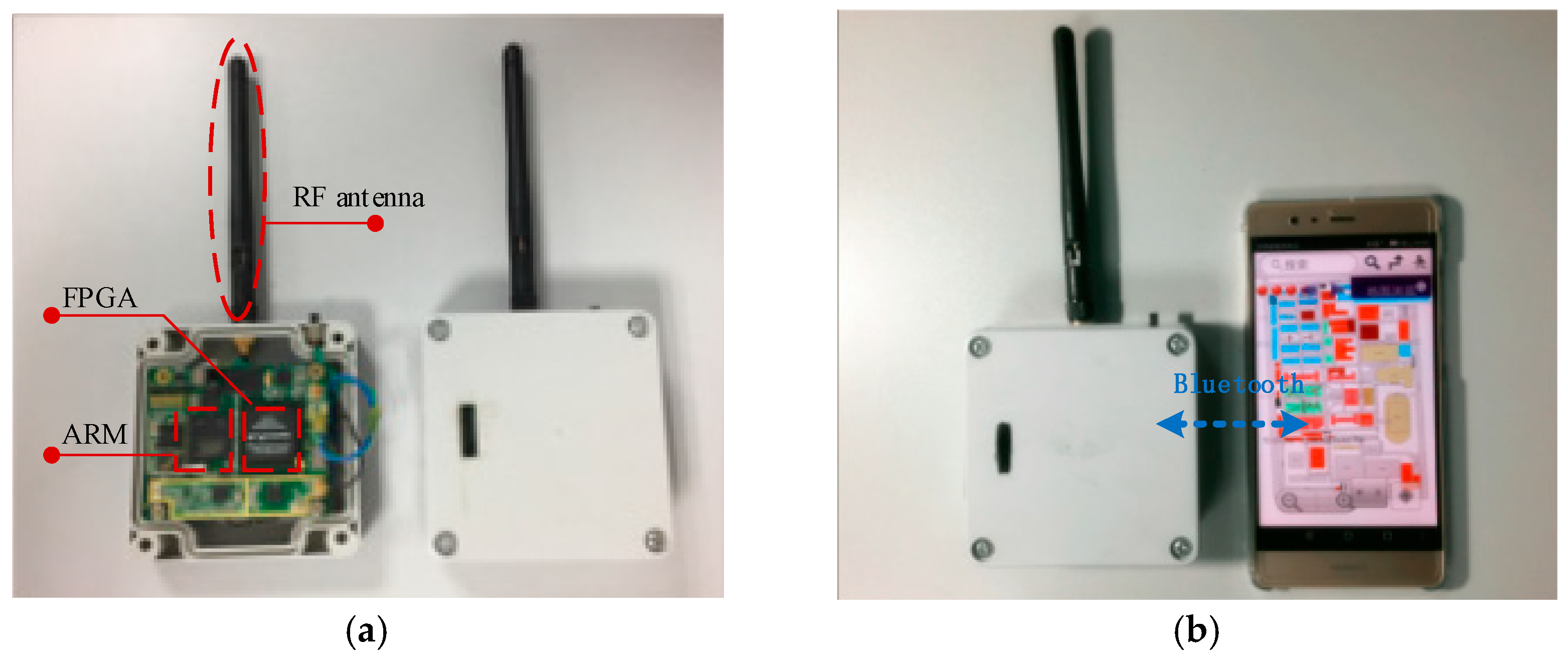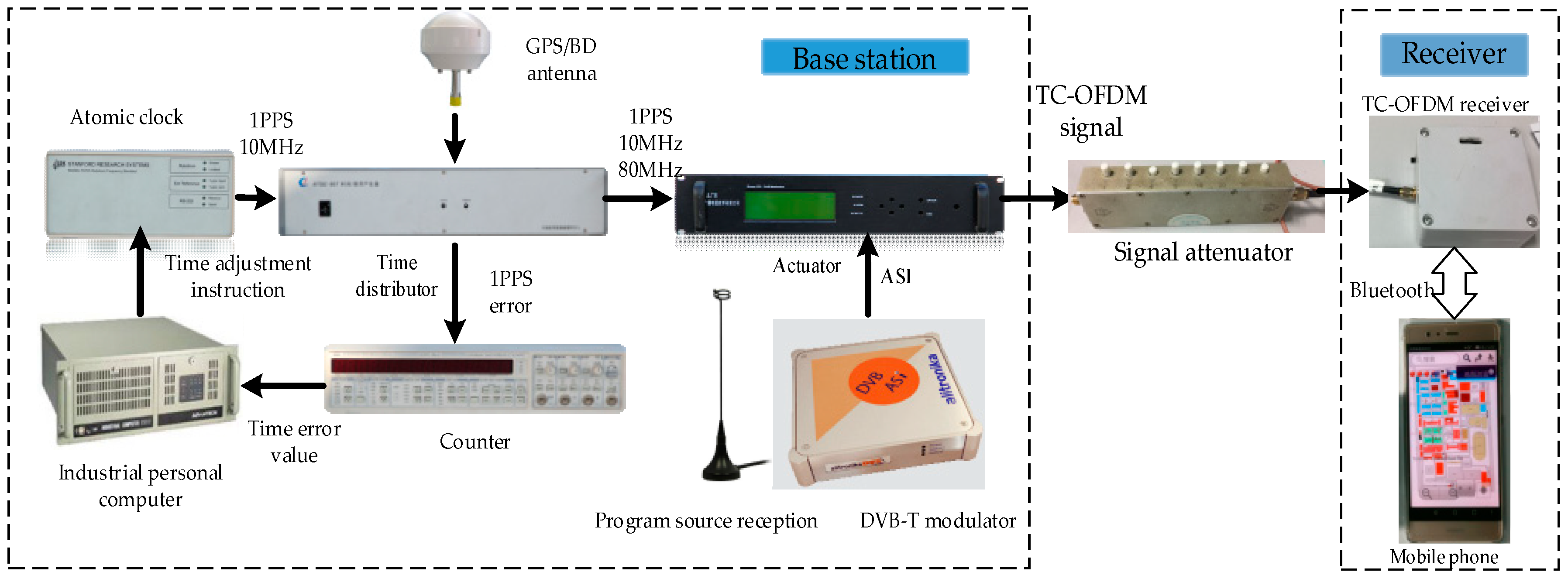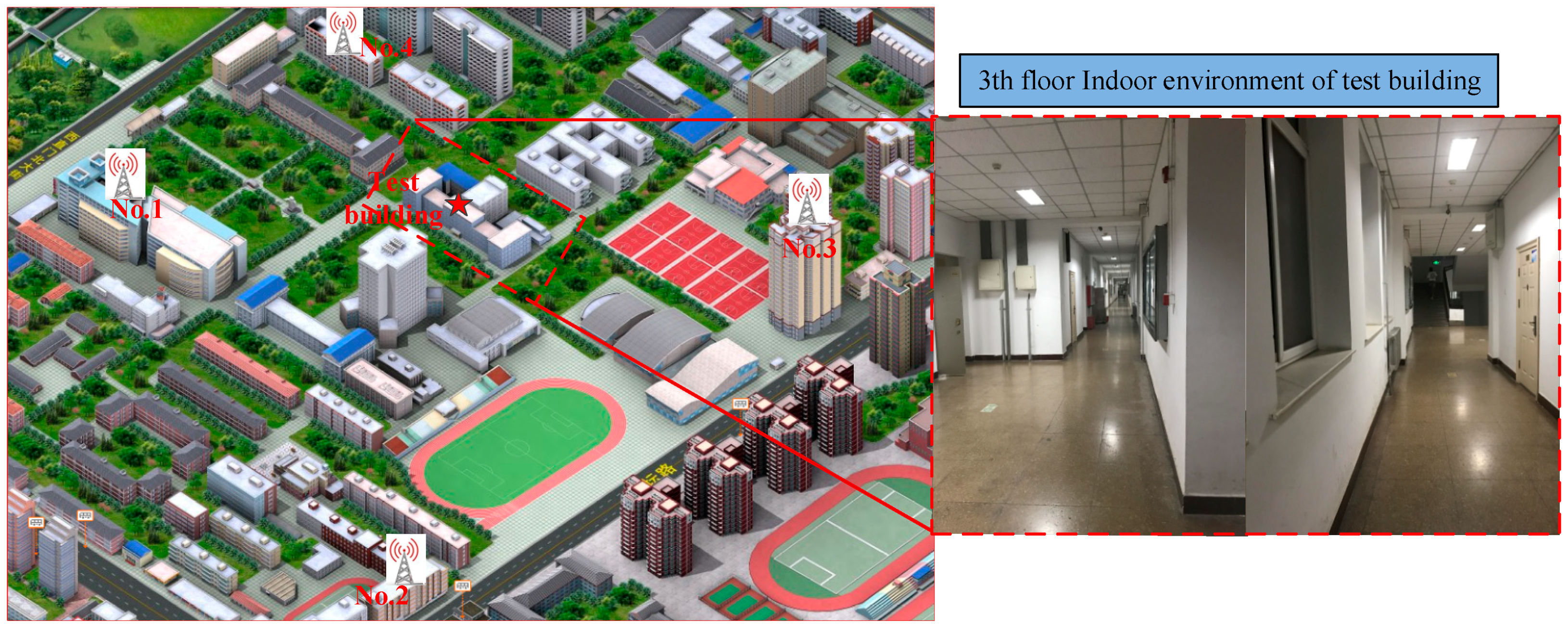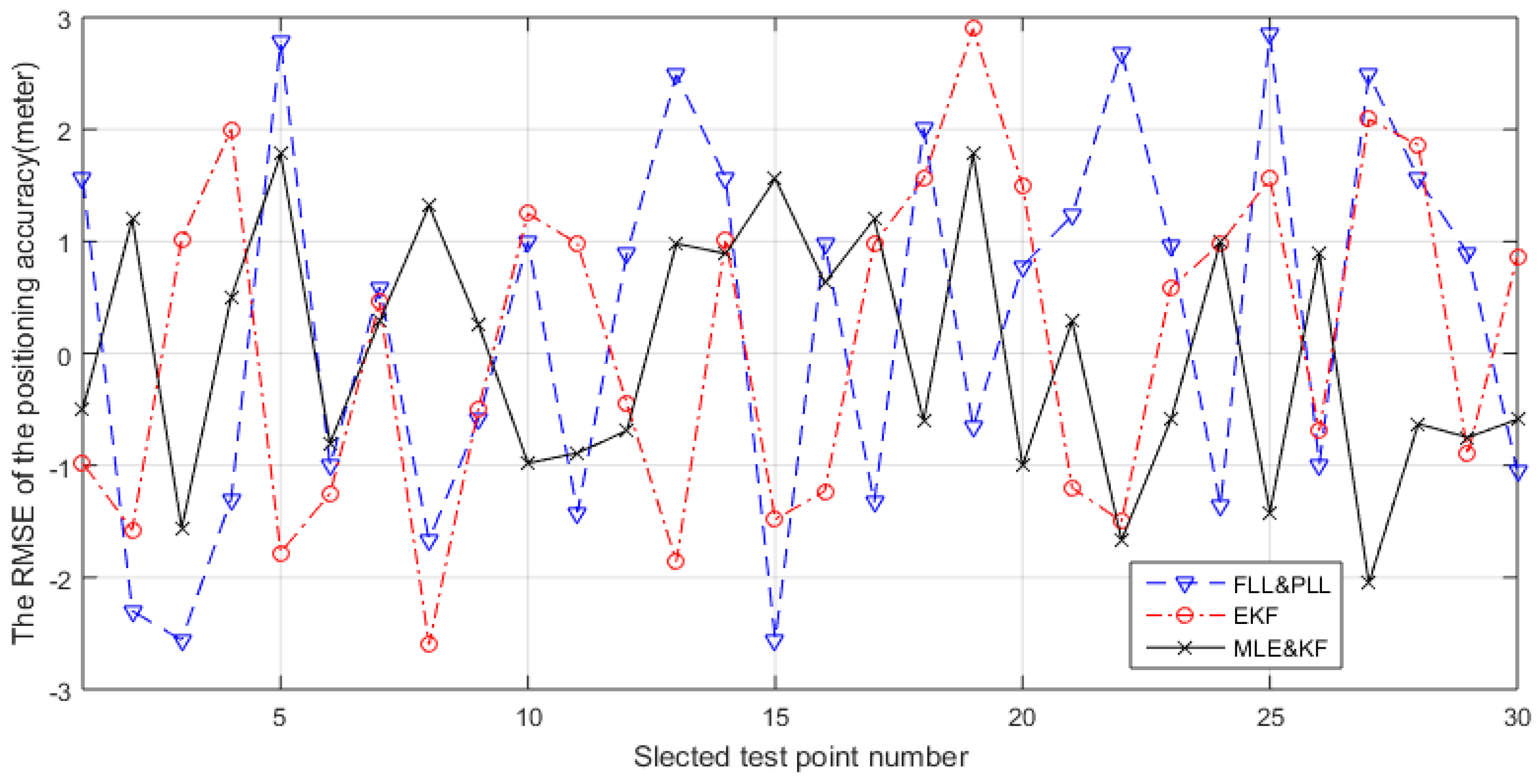1. Introduction
With the development of mobile Internet and mobile smart devices, location-based services have become the focus in many wireless network applications. In open outdoor areas, Global Navigation Satellite Systems (GNSS) can provide precise location information for outdoor activities, however, in buildings, urban canyons, and forested areas, the effectiveness of positioning using GNSS is limited, making it impossible to provide high-precision location-based services. Typical studies on the above problems in such harsh environments can be found in [
1,
2,
3,
4,
5]. A general framework to characterize the localization accuracy by unifying localization information of wideband wireless networks is proposed in [
1]. Reference [
2] established the fundamental limits of wideband cooperative location-aware networks. Centimeter accuracy indoor localization in an Assisted Living (AL) system is achieved for a 5G systems using millimeter-wave signals, which can be found in [
3]. Reference [
4] proposed a range information model which is a function of wireless environment, signal features and energy detection techniques. Soft range information-based localization can be found in [
5] for high accuracy network localization. Meanwhile, precise localization is of great importance in many applications such as vehicular networks [
6]. A state of the art vehicular communication system for the cooperative awareness of connected vehicles is proposed in [
7].
Studies show that people spend more than 80% of their time in indoors environments [
8]. With the increasing number of tall buildings, indoor location-based services have emerging applications in commercial applications and public safety. As the main positioning technology, GNSS has many significant advantages outdoors, such as a large coverage area, high positioning accuracy, and superior navigation performance [
9]. However, buildings obstruct, reflect, and diffract the GNSS signals, the positioning performance is limited in indoor environments and cities. Recently, terrestrial radio positioning systems and their enhancements to the GNSS have drawn increasing attention, and the digital broadcasting signal is a promising positioning signal for indoors uses [
10]. As for DVB-T/H signals, a different low-complexity solution to perform the coupling channel estimation in an on-channel repeater can be found in [
11,
12,
13]. This paper mainly studies a novel terrestrial radio positioning system called Time & Code Division-Orthogonal Frequency Division Multiplexing (TC-OFDM), which is based on the China Mobile Multimedia Broadcasting (CMMB) system. The TC-OFDM system multiplexes the CMMB signal and pseudorange noise (PRN) codes in the same frequency band, and the positioning performance can be achieved by adding some simple modifications to the deployed CMMB facilities. The positioning part of the TC-OFDM system is a direct-sequence spread spectrum code division multiple access (DSSS-CDMA) system employing binary phase shift keying (BPSK) modulation, and [
10] describes the TC-OFDM system in detail. Compared with the GNSS, the TC-OFDM system has many potential advantages: the TC-OFDM signal transmission power is stronger, the frequency band is the U band. The TC-OFDM receiver demodulates PRN codes for high accuracy positioning, which can overcome the positioning limitations caused by the CMMB single network coverage.
Weak signal strength is the main factor that limits the performance of the receiver tracking loop to improve tracking sensitivity. Meanwhile, the indoor environment is more complex than outdoors and the signal strength is significantly attenuated, which restricts the tracking performance of the existing receivers for weak TC-OFDM signals. The main reason is that the accuracy of the residual carrier estimation by the existing carrier loop algorithm is not ideal under weak signal conditions. Since the carrier loop is the weakest link in the receiver tracking loop, the superior carrier loop performance can improve the tracking sensitivity of the receiver for weak TC-OFDM signals to a certain degree [
14]. The carrier loop is usually divided into a frequency-locked loop (FLL) and phase-locked loop (PLL) [
15,
16]. The FLL has good dynamic performance, but the carrier phase measurement accuracy is lower due to the wide noise bandwidth [
17]. The PLL tracks the received signal more closely and has the high carrier phase measurement accuracy, but it has poor tolerance of dynamic stress [
18]. Due to the complexity of the indoor environment, the received signal strength is greatly attenuated. Therefore, the existing carrier loop performance needs to be improved for better performance in indoor weak signal environment. Currently, the methods to improve the carrier loop performance are divided into three categories: the KF-based PLL [
19], the algorithms based on the Maximum likelihood estimation (MLE) algorithm [
20], and the FLL-assisted PLL [
21]. The KF-based PLL includes Extended Kalman Filter (EKF) and Unscented Kalman Filter (UKF) algorithms [
22,
23]. The observation model in the carrier loop is nonlinear, which means the observed signal vector and the estimated state vector are nonlinear in the carrier loop. The EKF and UKF are utilized to expand the nonlinear observation functions using Taylor series and keep the linear part of the function while ignoring the higher order nonlinear part. However, the EKF and UKF based on linear minimum mean square error estimation criterion represent a sub-optimal carrier loop scheme, which still produces a large parameter estimation error for weak received signals. Methods based on FLL-assisted PLL can ensure the dynamic of the carrier loop but the estimation accuracy is limited in a weak signal environment [
24]. Reference [
25] uses the MLE to adjust the Doppler frequency in a high dynamics receiver carrier loop, but it does not make a detailed analysis for weak received signals. Iterative and non-iterative MLE are proposed to estimate the signal Doppler frequency and code phase in [
26,
27]. These two algorithms need to deal with real-time IF data, which means a heavy calculation burden.
This paper proposes a novel carrier loop algorithm based on MLE and KF for weak TC-OFDM signals. The main idea is to combine the MLE with KF to effectively estimate the carrier loop parameters and smooth the estimation results, so as to obtain an accurate estimation of the residual carrier for weak TC-OFDM signals and improve the receiver tracking sensitivity indoors. With the novel algorithm, the MLE discriminator function replaces the current carrier loop discriminator. The Levenberg-Marquardt (LM) algorithm is utilized to obtain the MLE cost function consisting of signal amplitude, residual carrier frequency and carrier phase, and the MLE discriminator function is derived from the corresponding MLE cost function. The KF is used to smooth the MLE discriminator function results, which takes the carrier phase estimation, the angular frequency estimation and the angular frequency rate as the state vector.
The rest of this paper is organized as follows:
Section 2 presents the signal model. The proposed carrier loop algorithm is introduced in
Section 3.
Section 4 presents the simulation and real data test results of the comparison between different carrier loop algorithms. Finally,
Section 5 concludes the work.
2. Signal Model
The CMMB signal and pseudorange noise (PRN) codes are multiplexed in the same frequency band.
Figure 1 shows the structure of the TC-OFDM signal. The duration of each frame of the CMMB signal is 1 s, and each frame consists of 40 time slots. The duration of each time slot is 25 ms. The CMMB system uses orthogonal frequency division multiplexing (OFDM) to transmit the broadcasting signal. Two kinds of pseudo codes are superimposed on the CMMB signals to provide high accuracy positioning services, which are named short codes and long codes, respectively. The beginning of the frame has the TxID and two synchronization signals. The TxID is empty in the practice CMMB signal, so the short codes are superimposed on the TxID to distinguish different base stations by using different pseudo codes signals. Thanks to the fact the TxID is empty, the short codes and the CMMB signals have the same transmission power. In order not to affect the normal communication of the CMMB signal, the power of long codes is lower than the CMMB signal by 20 dB [
10]. In the positioning, the receiver uses short codes to achieve acquisition and long codes to achieve stable tracking.
The TC-OFDM signal of the
nth time slot can be expressed as:
where the
SCMMB(
t) is the CMMB signal,
CSC(
t) and
CLC(
t) is short codes and long codes respectively. The superscript
i represents the base station number.
TF is the time length of the time slot and
TSC is the time length of the short codes. The term α is the signal attenuation factor.
In order to transmit the positioning-assisted information, the PRN codes sent by the base station are modulated with the positioning-assisted information, and each slot modulates one bit positioning-assisted information. The TC-OFDM signal of
ith base station can be written as:
where
d(
t) denotes the positioning-assisted information. The signal transmitted by the
ith base station is:
where
fc is the carrier frequency,
φ0,i(
t) is the initial phase.
The signal from the
ith base station is received by the receiver radio frequency (RF) antenna. The output signal of the RF antenna can be written as:
where
N denotes the signal received from
N different base stations.
A(i) is the signal amplitude,
τi is the incoming signal delay,
fc is the carrier frequency,
fd,i is the incoming Doppler shift,
φ0,i(
t) is the initial phase,
ω(
t) is the additive Gaussian white noise (AWGN) with zero mean and variance
σn2.
After the receiver RF front-end, down-conversion, low-pass filter and analog-digital conversion module (ADC), the digital intermediate frequency (IF) signal is expressed as:
where
Ts is the sampling duration,
AIF is the IF signal amplitude,
τi is the incoming signal delay,
fIF is the IF frequency,
fd,i is the Doppler shift,
φ0,i is the initial carrier phase,
ω(
n) is the additive Gaussian white noise (AWGN) with zero mean and variance
σn2.
The IF signal is sent to the baseband processor for acquisition [
10], tracking and data demodulation. A rough estimation of carrier frequency and code phase of the received signal is obtained from the acquisition process, which initialize the related parameters of the tracking channel. Then the estimation of these two signal parameters is refined step by step through the tracking loop. The numerically controlled oscillator (NCO) in the tracking loop produces mutually orthogonal sine and cosine signals, which can be created as:
where
and
is the carrier
NCO frequency and initial phase respectively.
In this research, the TCXO is used in the TC-OFDM receiver, and the accuracy of the TCXO is 0.5 ppm. After many real tests, we find that the phase noise of the receiver clock is smaller than white Gaussian noise in the research of the TC-OFDM meter-level positioning accuracy. Also, we can use the TCXO phase noise estimation algorithm to predict the actual phase noise. However, adding the TCXO phase estimation algorithm has less influence on the proposed algorithm in this research. Therefore, the effect of phase noise can be ignored in this research. After carrier stripped, the coherent integration result of I and Q channel signals by integration and dumping module can be created as:
where
Corr(
n) represents the
nth coherent integration result,
Tcoh is the coherent integration duration,
s(
n) denotes the positioning-assisted information,
Amp, Δ
f and Δ
φ represent the signal amplitude, carrier and phase residual respectively. In order to avoid bit transition, the coherent integration duration used generally do not exceed one time slot duration. We assume that in the coherent integration duration,
s(
n) can be regarded as a fixed value.
For the convenience of analysis, we assume that the local code is strictly aligned with the received signal. When in the coherent integration duration, the parameters
Amp, Δ
f and Δ
φ have minor changes which can be regarded as unknown nonrandom parameters. In the tracking process, the term of sinc(Δ
fTcoh) ≈ 1 when Δ
f is small enough. Then Equation (8) can be simplified as:
The conventional carrier loop structure is shown in
Figure 2. The coherent integration results of Equation (8) is sent into the carrier discriminator to estimate carrier frequency. Then the Carrier NCO is adjusted in real time based on the carrier frequency filtering results from the loop filter.
3. MLE Parameter Estimation Model
In the case of an unknown prior distribution of estimated parameters, MLE provides the parameter estimation with the smallest error variance when the parameters to be estimated is symmetric and unimodal distributions. In terms of the linear discrete-time system, linear KF is the optimal filter [
28]. Therefore, the MLE combined with KF can make an accurate estimation of the parameters in the carrier loop, which can improve the tracking loop performance. The MLE is used to nonlinearly estimate the carrier loop parameters of interest, and then KF is applied to smooth the estimated parameters from MLE. Therefore, the proposed algorithm of combining MLE with KF is the optimal solution for the TC-OFDM carrier frequency accurately tracking in the weak TC-OFDM signal environment.
3.1. The Principle of MLE
MLE is often used to estimate unknown non-random parameters. MLE is defined as the estimator of
θ value that maximizes the likelihood function. The estimated value is denoted as
θMLE(
x). We take the MLE for a single-parameter
θ as an example. For an unknown non-random estimation
θ, the probability density function
p(
x|
θ) of the observation vector (denotes as
x) is called the likelihood function. The basic principle of MLE can be explained as follows: for a selected
θ, MLE consider the probability
p(
x|
θ)
dx that
x falls in a small area, and take the corresponding
θ whose
p(
x|
θ)
dx is the largest as the estimated
θMLE(
x). As shown in
Figure 3, the likelihood function is obtained after
x =
x0, then we can draw a curve between the likelihood function and the estimated value of
θ. The value of
p(
x|
θ)
dx for each
θ means the probability that
x falls within d
x, and d
x centered on
x0 in the observation space R for
θ. When
x =
x0, it can be seen that
θ =
θ1 is unreasonable, so we choose
θ =
θ2 as the estimation, and the
θ that maximizes
p(
x =
x0|
θ) is selected as the estimated value
θMLE(
x) within a range allowed by the estimated
θ.
3.2. MLE Cost Function
Given a set of observations
x, the MLE of
θ is the
θMLE(
x) at which the probability density function is maximized:
According to the above analysis, when the likelihood function
p(
x|
θ) is known,
θMLE(
x) can be obtained by the following equation and the logarithmic form is given in Equation (11):
Since MLE is considered a valid parameter estimation algorithm in the tracking loop of the TC-OFDM receiver, we use MLE to effectively estimate the residual carrier frequency for weak TC-OFDM signals indoors. Meanwhile, the MLE produces the minimum variance of estimation error, when the statistical distribution of the estimated signal parameters in an uncertain interval is unknown [
29]. When it comes to multi-parameter problems, the MLE of signal parameters is the estimation of signal parameters when the joint conditional probability density of a set of signal observations gets maximized. Since the coherent integration time in the algorithm is 1.6 ms which is shorter than the loop update time, we assume that the carrier is correctly tracked within such a short coherent integration time. Therefore, the parameters to be estimated can be regarded as unknown constants over the interval. Meanwhile,
N is defined as the number of consecutive coherent integration results in this paper. The coherent integration results are adopted as observation sample parameters of MLE, which contains the signal amplitude, residual carrier and phase value in Equation (8). The value of
N is selected to ensure that the parameters to be estimated remain constant over the entire interval, and
N is closely related to the dynamic bandwidth of the receiver. The TC-OFDM system is for indoor positioning, which is mainly under low dynamic cases. In the low dynamic case, signal amplitude is the main change parameter. We use the MLE to estimate the signal amplitude, and other parameters (including residual carrier and phase) are little changed under such the low dynamic case. Also, the simulation and real test are used to determine the value of
N in this research. Therefore, in order to obtain the MLE of the unknown
Amp, Δ
f and Δ
φ in Equation (8), the joint probability density function of
N consecutive coherent integration results is obtained according to [
30]:
where
CorrN = [
Corr(0),
Corr (1),
……,
Corr (
N − 1)] represents
N consecutive coherent integration results,
is the estimated value of
.
W is the diagonal matrix which stands for the weight factor of
Corr(
n), superscript
H denotes the matrix transpose and conjugate operations.
The MLE minimum variance unbiased estimation can be achieved by obtaining the maximum value of (10) to get the values
Amp, Δ
f and Δ
φ. The diagonal elements of the diagonal matrix
W are set as 1 to obtain the log-likelihood cost function of Equation (12) as in [
31,
32]:
where
Corrn =
Corr(
n),
CorrN = [
Corr(0),
Corr (1), ……,
Corr (
N − 1)] is
N consecutive coherent integration results.
μ = [
Amp Δ
f Δ
φ]
T represents the signal parameters to be estimated,
n = 0…
N − 1,
θ = 2
πΔ
fnTcoh + Δ
φ,
and
represent the real and imaginary part respectively.
By finding the maximum value of Equation (13) to get the estimated value of
μ, which can be expressed as:
Deriving the partial derivative of
μ:
when
, the estimation value of
Amp is obtained:
The signal amplitude
Amp estimated in the MLE is used to subsequently adjust the observation noise covariance matrix
R in the KF. Since the items of |
Corrn|
2,
Amp2 and
Nln(2
πσ2) in Equation (13) do not affect
partial derivative of Δ
f and Δ
φ respectively, we can remove such irrelevant items and the cost function is simplified as:
where
θ = 2
πΔ
fnTcoh + Δ
φ,
and
represent the real and imaginary part respectively.
We can find that if θ is obtained, then Amp can be calculated by Equation (16). According to the relationship between θ, Δf and Δφ, θ can be obtained as long as we get the value of Δf and Δφ. Thus Amp can be acquired by Equation (16), the rest is to estimate the value of θ, which is equivalent to get the value of Δf and Δφ. Solving the problem of θ in Equation (17), which the essence is to obtain the values of Δf and Δφ. Getting the value of Δf and Δφ can be regarded as the process of solving a two-dimensional optimal problem. Therefore, the MLE solution of Δf and Δφ in θ is transformed to solve the two-dimensional optimal solution by Equation (17).
3.3. LM Algorithm
The LM known as the damped least-squares (DLS) method, is one of the most effective algorithms to solve nonlinear least squares problems, which has both the advantages of gradient descent method and Gauss-Newton algorithm (GNA). The LM uses a gradient to find the maximum (minimum) value and obtains the optimal solution through iterative convergence. The (non-negative) damping factor
λ is adjusted at each iteration. When
λ is used as a smaller value, bringing the algorithm closer to the GNA, whereas if an iteration gives insufficient reduction in the residual,
λ can be increased, giving a step closer to the gradient-descent direction. We use the LM algorithm to iterate to get the frequency and phase values in the paper. The duration of the coherent integration time is 1.6 ms, which is consistent with the LM iteration time. And the loop adjustment period of the carrier tracking loop is 25 ms. Since the LM iteration time is less than the loop adjustment period, the algorithm proposed in this paper can ensure the real tracking. Therefore, the LM algorithm is used to solve the two-dimensional optimal solution in Equation (17). The iterative optimal solution is given by the following equation:
where subscript
i represents the number of iterations,
is an 2 × 1 state vector including Δ
f and Δ
φ,
λ is an 2 × 2 diagonal matrix, used to ensure that
Hi +
λ is positive definite and adjust the iterative convergence rate.
Hi and
Gi is 2 × 2 pseudo-Hessian matrix and 2 × 1 gradient vector respectively.
Hi and
Gi can be written as:
where
The entire LM algorithm iterative process is shown in
Figure 4. The first step is to initialize the value of
and
λ. Since we assume that the carrier is correctly tracked at the beginning then
and
λ initialized to an experience value. Next, Equations (19) and (20) are utilized to get
Hi and
Gi. Increasing
λ to make
Hi +
λ positive definite. Then Equation (18) is used to update
and Equation (17) is used to judge whether
is satisfied. If not, continue to increase
λ. If satisfied, judging the gradient vector
G is less than 0.2 or greater than 0.8 (the judgment condition for
G is set according to the actual test), then adjust
λ according to the conditions respectively satisfied. The physical meaning of adjusting
λ is that if the estimated value
is closer to the optimal value of iteration, then increase
λ to slow down the convergence rate, otherwise decrease
λ to accelerate iterative convergence. The termination condition of the above iterative process is that the value of the gradient vector
G falls below predefined threshold (Pre_Thres) or the number of iterations (Iter_Num) exceeds the set maximum (Iter_Max).
3.4. KF Model
MLE can obtain the minimum error variance of parameters without relying on the prior distribution of signal estimation parameters. For MLE, the choice of the number of observations
N is significant. The reason is that if a small value of
N is adopted, the observed sample value of MLE is small, thus the estimated result cannot reflect the true data very well. Conversely, if the observed value of
N is large, excessive observation noise will be introduced, which is not beneficial to obtaining accurate results. Therefore, if we use the estimated frequency directly in weak signal environment, the non-negligible estimated error in the carrier loop will occur, and finally restrict the improvement of tracking sensitivity and accuracy under weak signals. Since KF is the optimal filter in linear discrete systems [
33]. KF is adopted in this paper to smooth the estimation of the parameters after a non-linear estimation by MLE. Therefore, for the carrier frequency tracking problem of TC-OFDM system, the combination algorithm of MLE and KF is the optimal solution. The proposed carrier loop structure is shown in
Figure 5.
The main idea is to use MLE to get the estimated value of Δf and Δφ, and KF to smooth the MLE parameter estimation error to get more accurate Δf and Δφ. The output value of the KF is used to adjust the carrier NCO. The MLE uses the LM iteration to get the next value of Δf and Δφ. In practical application, the form of KF is closely related to the state equation and observation equation.
The state equation describes the behaviour of the state vector. In order to adjust the carrier loop accurately, the state vector in the selected carrier loop is expressed as:
where
φ is the carrier phase estimation value,
ωd = 2
πΔ
f denotes the angular frequency estimation value,
represents the angular frequency rate.
The state equation can be expressed as:
where
Wk−1 is the input Gaussian white noise with mean zero and variance
Q,
is the state transition matrix and the form can be written as:
where
T =
NTcoh is the loop update period.
The observation equation describes the relationship between observations and state vectors. The observation equation can be expressed as:
where
H is the observation matrix, the form can be written as:
The value of the rate of change of Doppler in the observation matrix H is a predetermined experienced value. The preset value is reasonable which satisfies the current applications in the TC-OFDM system. And this kind of pre-setting for the rate of change of Doppler is beneficial to us to further study the TC-OFDM receiver algorithm in high dynamic scenario.
Vk is the observed noise, the mean is zero and the variance matrix is
R. The phase difference
between the input signal and the local signal can be expanded by the Taylor series:
where
is the carrier phase,
is the residual carrier and
is the rate of change of Doppler.
The form of
can be written as:
is the remainder of Taylor expansion, which is used to represent model noise and describes the effects of random interference and model inaccuracy as described above.
is a zero-mean, white Gaussian noise process with a single-sided spectral density
Ny. The noise variance can be expressed as:
and the value of
can be obtained:
Then the variance matrix
Q can be derived:
where
.
The forms of
Q and
R can be respectively denoted as [
34]:
where
I is the unit matrix.
The σv2 in R is adjusted according to the value of Amp estimated by MLE. For the σv2 in the observation covariance matrix R, we obtained a series of experience values based on multiple experiments during the algorithm experiments. According to the estimated value of the signal amplitude Amp obtained in the MLE, these experience values are utilized to adjust the preset value of the σv2.
The KF algorithm obtains the filter value at the current time according to the state estimation value at the previous moment and the observation value at the current time. The entire carrier loop filtering process can be divided into two parts, the state estimation and state prediction. The output state estimate
Xk of KF and the variance matrix
Pk of the estimation error can be iteratively calculated by the following equations:
From Equation (36) can be seen that when Rk is large, the corresponding Kk will be small, then the state estimate calculated by Equation (37) is small; when Qk is small, one step prediction covariance matrix Pk,k−1 calculated by Equation (35) will be small, which lead to a smaller state estimate Xk−1 finally. From the above analysis, it can be seen that every update of the system state by KF is a compromise between the current system state uncertainty and the observation uncertainty. Therefore, in this paper, Rk and Qk are obtained by real-time statistics of noise on historical observation and current observation to enhance the adaptability of KF to noise.


